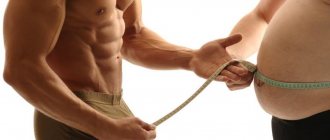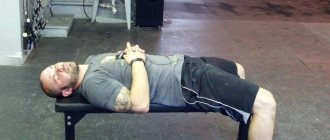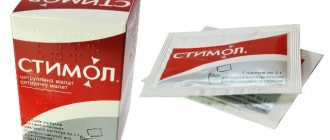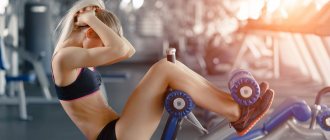Content
- 1 FST-7 1.1 The essence of the FST-7 training program
- 1.2 Should I continue to train hard or can I just pump with light weights?
- 1.3 How often should you train each muscle group?
- 2.1 When to do “7 approaches”?
- 3.1 During training
FST-7 training tips
- FST-7 - or any other training system - can be most effective if you can fully recover from it. Make sure your recovery is always complete.
- Both the basic exercises and the 7 isolation sets should be performed to failure in order to recruit as many muscle fibers as possible.
- Just because you're doing 7 sets of one exercise doesn't mean using light weights. Train as hard as possible to reach failure without compromising your form. This will stimulate as many muscle fibers as possible.
- You can perform FST - 7 both on machines or cable trainers, and with free weights.
FST-7[edit | edit code]
FST-7
FST-7
(FasciaStretchTraining—Seven) is a training program that is popular in the United States and is aimed at higher-level athletes. Its popularizer is Hany Rambod.
- Fascia
(fascia) is a connective tissue membrane that covers organs, vessels, nerves and forms cases for muscles in vertebrates and humans; performs supporting and trophic functions; - S
tretch (Stretching) - increase, lengthening, expansion; - T
raining - the process of bringing a person to an agreed standard using instructions and examples; - 7
- the number of sets additionally performed for each muscle group.
The essence of the FST-7 training program[edit | edit code]
The FST 7 training program is a combination of strength training and pumping. Many famous bodybuilders have advertised this program, but to date there has been no actual evidence of effectiveness. Most of the training according to the FST-7 program is taken up by strength training, and intense pumping is added at the end. By the way, the number 7 indicates the number of approaches at the end of the workout to pump blood into the muscles. You should switch to high-intensity training only after strength work; if you pump at the beginning, you will not be able to train normally with your working weights.
The basic principle of fascial stretching training
- performing the final 7-set exercise for a muscle group. That is, on a given day you train a separate muscle group, performing your usual heavy sets of 8-12 repetitions, but after that you finish off the muscles with an additional 7 sets with minimal rest in between, getting the maximum possible pump.
An important point: small muscles such as biceps, triceps and calves (calf) can and should be worked twice a week, while large muscles should be worked only once a week. For example, like this:
- Biceps, Triceps and Calf
- Legs
- Rest
- Chest and Triceps
- Back and Shin
- Shoulders and Biceps
- Rest
It is necessary to refrain from performing multi-joint exercises as "seven sets" because they require balance and the use of accessory muscles, which take the focus away from the target muscle. Machines and cables, as well as free weights like curved barbells, work well for this. Advanced athletes can, for example, move the “seven sets” to the beginning of working the muscle. This method shocks the muscles, which leads to even greater muscle growth.
The main goal of the technique
— delivery of as many vitamins, minerals, amino acids, oxygen, etc. as possible. into the muscle, as well as stretching the fascia that surrounds it - this allows you to achieve maximum muscle growth. Fascia is a limiting factor in muscle growth, because the muscle grows only as long as there is free space. This technique allows you to stretch the fascia and make room for muscle growth.
There are 3 types of fascia in the human body, but bodybuilders should only pay attention to one of them - the deep fascia. It is dense fibrous connective tissue that surrounds the muscles, bones, nerves, and blood vessels of the body. The high density of this collagen fiber provides the deep fascia with its strength and integrity. Its expandability and elasticity are determined by the number of elastin fibers. In other words, some of us have fascia that is thicker and more rigid than others. Genetically gifted bodybuilders have thin fascia, which makes their muscles look larger and more puffy. Ronnie Coleman and Phil Heath are examples of people with thin fascia. Their muscles expand more easily. Think about it: a balloon is easier to burst than a plastic water bottle. Jay Cutler and Nasser El Sonbatty are two examples of people with thick fascia. This hasn't stopped them from gaining more muscle mass, but their muscles look round, like in a Marvel comic.
However, the average bodybuilder has even thicker fascia than these two champions. In order to stretch their fascia and make the muscles grow, some of them take deep injections of Synthol. There are even advisers on the Internet who claim that this is the only way. I dare to assure you that this is not true. Synthol and similar products are substances foreign to the body and you can never be sure how it will be accepted by the body. There are already known cases of health problems caused by the use of such drugs. Yes, we need to expand the fascia for muscle growth, but not this way!
Types of stretching are not the same
The first people to understand the importance of fascial stretching were John Parillo and Dante Trudel, who incorporated aggressive stretching into their workouts. They had the right idea, but stretching the fascia with muscle stretching is not a good method. FST-7 is based on stretching the muscles from the inside by increasing volume.
Should I continue to train hard or can I just pump with light weights?[edit | edit code]
You need to understand that pumping in FST-7 is only one of the components of the technique, and not its main part. The stronger the muscle, the larger it is, so you should definitely train with heavy weights in the range of 8-12 repetitions. Heavy weights will give you thickness and density, but they won't give you good visual shape. Also, working only on pumps will give you curves, but you will not achieve large muscle mass without heavy weights. As a conclusion, you must simultaneously work on both strength and pump in each of your workouts in order to achieve optimal results.
Here is an example of biceps work using the FST-7 system, taking into account both:
- Alternate dumbbell curls - 3-4 sets of 8-12 reps
- Machine preacher curl: 3 sets of 8-12 reps
- EZ Bar Raises 7 sets x 8-12 reps (30-45 seconds rest between sets - drink water to help hydrate muscles and further stretch the fascia)
Think of these 7 sets as like popping a balloon. We take short breaks between approaches, because during rest the blood runs away from the muscle and we do not achieve the maximum pump. It's just like trying to blow up a balloon that's escaping air. The main task is to gradually pump up the muscle over 7 approaches, so that the last of them is maximum. If you take even less rest between sets, you won’t have enough energy to do your best in 7 sets.
Should the weight be constant for all 7 sets? Maybe, but it's better to reduce the weight 1-2 times to be able to complete all the repetitions. In some cases you can even gain weight, but this is rare
How often should you train each muscle group?[edit | edit code]
In general, this type of training is too traumatic to train large muscles more than once a week. Due to the limited volume of muscle cells, their sensitivity takes too long to restore. For example, Phil Heath once pumped his back and it clogged him for 4 days. Since he planned to train his back and chest twice a week in preparation for the Arnold Classic, this threw a wrench into his schedule. The higher than normal amount of muscle tears caused by the FST-7 System requires a longer recovery time than with other techniques. However, small muscles (arms, lower legs) can be worked twice a week. This gives you twice the chance of toning those stubborn muscle groups. Here's an example of how you could do this:
- Biceps, Triceps and Calf
- Legs
- Rest
- Chest and Triceps
- Back and Shin
- Shoulders and Biceps
- Rest
This was an example for a person trying to grow “stubborn” hands. There may be other options depending on what you want to focus on.
STAGE S – DUMBBELL FLIES ON AN INCLINE BENCH
After a good contraction of the upper chest, it is necessary to bring these muscles back to their original length by bending over, stretch them and thus increase the micro tears of the muscles, which during the recovery process will become thicker and denser, thus increasing the strength and volume of the muscles.
In this exercise, the key is not the weight, but the degree of stretch, technique and feeling of the muscle. Make sure that excess weight does not turn the dumbbell curl into a regular press, otherwise the work will additionally involve the triceps, the freshness of which is important when performing the T stage.
The exercise also involves 3-4 approaches, but the number of repetitions is 12-10
1 set x 12 reps
rest – 60 seconds
2 set x 12 reps
rest – 60 seconds
3 set x 10 reps
rest - 60 seconds, after not a second of rest more, we enter stage T
Don’t forget to drink enough liquid, water should literally be next to you, after these 2 exercises with such short rest intervals, you will feel not only “clogged” muscles, but also sweat will flow in a stream, simultaneously removing important microelements.
What exercises are best for the 7 Sets? [edit | edit code]
Certain exercises are better suited to the “7 sets” than others. Compound compound exercises such as deadlifts or squats are poor choices for two reasons:
- They involve other muscles and prevent them from giving full load to the target muscle;
- Good technique and balance are required, which deteriorate when you try to complete a large number of sets in a short time.
Exercise machines are a good choice because... they isolate the working muscle.
When to do “7 approaches”?[edit | edit code]
The best option is the final exercise for the muscle group. If you put them at the beginning, it will prevent you from working the muscle with heavy weight. Completing the work on the muscle with a pump has been instinctively used by top builders for many years, not knowing that they are working to expand the fascia.
Remember - “7 sets” is the final pump for a muscle group. If you are working for several groups on a given day, each of them should end with “7 approaches”.
How to select a load to stretch the fascia?
You should be aware that the load is selected in accordance with your goals.
In this case, we need to achieve maximum blood pumping into the targeted muscles. In this case, the main condition must be observed - perform seven sets of 8–12 repetitions each. It is clear that moderate working weight should be used. Otherwise, you will not be able to complete the required number of approaches and repetitions with a minimum pause. It is quite difficult to give specific advice in such a situation and it is better for you to conduct an experiment. However, based on our own experience, we can say that compared to strength work, the weights need to be reduced by about a third. It is also necessary to warn that it is possible that already during one of the seven sets the weight will have to be reduced, since the energy may run out. Don't worry about this, as the situation is natural.
If necessary, you can change the rest time between sets in any direction. However, this should only be done if it allows you to enhance the pumping effect. For example, if you're working on your arms, you'll probably need less recovery time compared to your chest.
It’s not difficult to understand that additional stress can significantly reduce the body’s recovery abilities. Be careful when using the fst 7 bodybuilding training program to target large muscle groups. During their training, the body already consumes a large amount of energy.
Once again we have to admit that it is impossible to give universal recommendations in this matter, because we all have different genetic data and levels of training. It’s still not worth using the pumping effect often at the same time as serious strength work. However, no one bothers to use this system throughout the week, when the body is not subject to a large load.
In this regard, it is necessary to remember microperiodization. If you are not using it in your training yet, we strongly recommend that you start doing so. This principle is used by all pro-builders, why not amateurs too.
See more about FST 7 workouts below:
Pre-workout nutrition - pumpim pump[edit | edit code]
Pre-workout nutrition provides the body with the raw materials it needs to ensure an intense and productive workout. I like my clients to eat at least 2 large meals before training that contain both protein and complex carbohydrates. The source of protein can be chicken or turkey, white fish or even cut of meat. A good source of carbohydrates would be oatmeal, potatoes or brown rice. These are long-burning carbohydrates that provide long-term nutrition, unlike fruits and simple sugars, which are quickly absorbed and can lead to a lack of insulin during training. Proper hydration is also important for the diet. This is especially important for those who take thermogenic products - many of them have a diuretic effect, which means an increased need for fluid restoration. Please note that we are talking about plain water, not mineral water. Carbonated drinks take up more space and you end up not getting drunk. How long before training should you eat? In general, your last meal should be an hour before your workout. The exception is leg training. Since heavy leg training is more metabolically demanding, you need to eat 1.5 hours before it. These are just the basic principles. If you are hungry within 1.5 hours of your last meal, you can eat less than an hour before your workout. Conversely, if you digest food slowly and feel nauseous during training, take a longer break. Avoid fatty and sugary foods - this will help avoid nausea.
During training[edit | edit code]
During training, you need to consume enough water. Take 150 ml of water (preferably slightly salted) 10-15 minutes before training, then 1-2 sips between sets. After training, you can drink water as much as you want. You will need more water in the summer, especially if you train in a gym that doesn't believe in air conditioning, or outside.
You can use a carbohydrate or thermogenic drink, but don't forget about plain water. If you drink one of these drinks during your workout, also take a bottle of water and alternate between them. It is worth emphasizing once again that there is no question of pumping if you do not drink enough water before and during training! As you know, our body and especially our blood are 70% water. Therefore, you should drink enough to maintain adequate fluid levels in your body.
Read more:
Water during and after training
After training[edit | edit code]
Within 15-20 minutes after finishing your workout (or better immediately), you need to drink a shake to start the recovery process and achieve muscle growth. Either way, you can't go wrong by taking protein sources like whey protein isolate with fast-digesting carbohydrates like dextrose, maltodextrin. If you're an ectomorph hardgainer, don't be afraid to mix multiple carbohydrate sources together. You can even add fruit juice or another simple carbohydrate for flavor. If you are cutting or gaining weight quickly, limit carbohydrates.
About an hour or two after your workout, eat a meal similar in composition to what you ate before your workout. For better digestibility, try to limit fats, especially saturated fats. The time until this meal may vary depending on the size of your post-workout shake. If you drink a big shake that fills you up, it may take 2 hours before you eat.
Nutrition
I probably don't need to remind you, but I'll say it anyway: If you don't eat enough of the right foods, there is no program in the world that will help you gain quality muscle mass. But if yes, then there are some simple tricks that can help you with this.
First of all, make sure you consume more carbohydrates on arm training days. You should eat starchy, more complex carbohydrates, such as potatoes or pasta. Arm days definitely shouldn't be one of the low carb days.
Eat red meat in at least one of your meals on arm training days. Saturated and monounsaturated fats + natural creatine found in red meat will help you increase muscle strength.
Finally, if you are on a cheat meal diet, use it wisely. Plan this meal the day before your arm workout so you can load up on carbs and get ready for that workout. Eat with something like sushi or flan for dessert. You need a lot of muscle glycogen for an intense arm workout!
An example of training using the FST-7 system[edit | edit code]
Biceps
:
- Alternate dumbbell curls: 3-4 x 8-12
- Machine preacher curl: 3 sets x 8-12
- EZ-bar lift: 7 x 8-12
Triceps
:
- Close grip bench press: 3-4 x 8-12
- Extension with dumbbells or in the machine: 3 x 8-12
- For the average: Straightening arms with cable overhead: 7 x 8-12
- Advanced: French Bench Press: 7 x 8-12
Breasts
:
- Incline dumbbell press: 3-4 x 8-12
- Incline dumbbell flye: 3 x 8-12
- Flat Hammer or Dumbbell Bench Press: 3 x 8-12
- Pec deck or putting your hands in front of you with cables: 7 x 8-12
Deltas
:
- Seated dumbbell press: 4 x 8-12
- Lifting dumbbells or barbells in front of you: 3 x 8-12
- Standing dumbbell fly: 3 x 8-12
- Raising arms to the sides in the machine: 7 x 8-12
Rear delts
- Bent-over dumbbell flyes: 3-4 x 12-15
- Reverse flyes in the Peck-Deck or cable machine: 7 x 12-15
Back muscles
:
Warm-up
:
- Regular grip pull-ups: 3 x maximum
- Wide grip block row: 3 x 8-12
- Bent-over barbell row: 3 x 8-12
- Hammer Strength row: 3 x 8-12
- Pullover in a loom or with a cable: 7 x 8-15
Trapeze
:
- Shrugs with dumbbells: 3-4 x 8-12
- Shrugs in the machine: 7 x 8-12
- That's right: tilt your torso slightly forward and shrug your shoulders to an imaginary point behind your ears - without making rotational movements with your shoulders. The repetitions should be performed slowly, with a second delay at the top.
Biceps hamstrings
:
- Lying leg curls: 3-4 x 10-15
- Deadlift on straight legs: 3-4 x 10-12
- Single leg curl: 3-4 x 10-15 per leg
- Seated leg curls: 7 x 10-15
Quadriceps
:
- Leg extension: 3-4 x 8-15
- Squats: 4 x 8-12
- Hack squats or leg press: 3 x 8-15
- Leg extension or leg press: 7 x 8-15
Shin
:
- Standing calf raise: 4 x 10-12
- Seated calf raise: 4 x 15-20
- Shin in the leg press machine: 7 x 10-12
Let us repeat the main provisions of the system
:
- you need to perform the final 7-set exercise for the muscle group;
- rest between approaches in a 7-set exercise should not exceed 30-45 seconds;
- it is necessary to consume water between approaches to further stretch the fascia;
- Multi-joint exercises should be avoided;
- pumping large muscles once a week, small ones - twice a week (but this is individual);
Features and Benefits
The author argued that there is one unshakable rule. When performing physical exercises, you should use the correct pumping, be guided by theory and apply practical skills in practice. A training program cannot be developed from numerous arm splits or working one muscle group every day.
Its composition looks like this:
- First day. Work on the lower leg, biceps, shoulders.
- Second. Leg exercises.
- Third. In the morning, a light jog that doesn’t put any strain on the body. The rest of the day is at your discretion.
- Fourth. Triceps, biceps.
- Fifth. Chest, lower leg.
- Sixth. Triceps, back.
- Seventh. Day off in free mode.
By training according to this system, athletes will see one truth. Over the course of seven days, small muscle groups are loaded twice. Then, like serious muscles, one. Moreover, at the end of each exercise, the training ends with a 7-set repetition for the department being worked.
That is, the implementation of the set goals is unchanged. Let’s say, according to the program presented above, today is Tuesday. Leg exercises are performed as standard. 8-12 repetitions and rest for 2-5 minutes.
At the end of each set, 7 approaches are performed with minimal rest between them. Thus, pumping allows you to finish off the muscles as required.
Multi-joint exercises are not used in the FST-7 program. Their job is to support auxiliary muscles, which take on part of the load.
But using exercise machines with weights or a curved barbell will provide the necessary results. When an athlete reaches his own limit, he moves the final stage to the beginning. This is an incredible shock for the body, which forces it to adapt. Growth is 100% guaranteed.
Back training by Phil Heath according to the FST-7 program
Back training only once every 7 days! The auxiliary exercises must be updated every 28 days. This rule applies to all other muscle groups.
FST-7
- wide grip pull-ups (perform at maximum amplitude) 3 sets to failure
- pull-ups with a medium (regular) grip (maximum amplitude) 3 to failure to failure
- Bent-over barbell rows 3 sets of 8-10 reps
- seated rows 3 sets of 8-12 reps
- dumbbell rows 3 sets of 8-12 reps
- straight arm row* 7 sets of 6-8 reps *Attach a rope handle to the cable of the upper block, firmly grasp its ends and straighten your arms, then pull the ends of the rope handle in an arc downward, towards your hips
If you are natural and still decide to try this program, then I want to emphasize that it involves a very, VERY large amount of training on the back muscles. To perform it, you will have to use either too small weights and therefore the muscles will not grow. Or you will need years of training to train your muscles to withstand such volume with large weights. In general - I do NOT recommend it. For straight people, the programs look like this.
FTS 7 program
- this is a training scheme, or rather a training technique, which was developed by the famous American trainer Honey Rambod.
Who is it?
This is the bald guy who trained Jay Cutler and Phil Heath.
This, on the one hand, should, of course, inspire respect, and, on the other hand, it should make us live. Why?
Because this absolutely means that FST 7 is working, since both Jay Cutler and Phil Heath win -if at the Mr. Olympia competition, but this also indicates that this technique is suitable for a very high level of performance. And here we are not only talking about the hundred or far-ma-ko-lo-gi-ches-support, but specifically about the gene-ti-ches-pre-race-lo-wives -nose. All professional athletes, especially champions, have a muscle complex with a large number of fast movements only a few, which is why their organism is not only capable of “bearing” such a load, but also of reacting to she grew up.
For an ordinary person, especially one who does not use steroids, the FST 7 program will most likely not be suitable, or rather, this technique can be re-used in training -ditch, but not on the po-yang island. The bottom line is that it is impossible to hypertrophy the myo-fibrillar ap-parat of cells by “pumping”. Pumping
- this is a method of hyper-trophy of sar-ko-plaz-ma-ti-ches-ko-go re-ti-ku-lu-ma cells, as well as a method of “pumping” the muscle with blood, that is , nourishment with substances and hormones. That’s why FST 7 can help an ordinary person during the recovery period of training, and a gifted professional on-lu, using steroids, and during the strength phase. The principle of the absence of “bad programs” applies here. Each program is good, but, first of all, it is not necessarily the most effective al-ter-na-ti-voy, and, secondly, it doesn’t suit everyone and not always!
FST 7 options
Classical:
This option involves performing 7 approaches of 12 repetitions with a 30-second rest between them at the end of the workout for the target muscle group. This method a priori implies a 5-6 day split, when the athlete trains all muscle groups separately. Thus, the athlete performs the usual strength training using 2-3 basic exercises, and at the end of the training he completes 7 lifts. moves iso-li-ru-yu-sche-exercise. This method is suitable only for “hi-mi-kam”, since there is such an abundance of basic forms of training in the recovery phase -raz-no-niy doesn’t-ra-zu-me-va-et.
Breaking:
in this case, 7 approaches of the FST system are placed after 1-2 exercises, depending on the training volume. If an athlete performs only 4 exercises, for example, 2 basic and 2 isolating exercises, then an exercise of 7 approaches comes after 2 exercises, if There are 3 exercises in total, then after the first one. The point is that after completing the basic exercise, the athlete pumps blood into the muscles, and then performs isolating exercise in the usual mode, which allows you to achieve “from-ka-za” in the target muscle group. In its own way, this is a version of the Mai-ka Ment-tse-ra system.
Preliminary:
This option involves “pumping up” the target muscle group in the first training, followed by the usual high-intensity training.
This option can be used by “naturals” when training large muscle groups. The point is that this method allows you to reduce working weights, while achieving “from-ka-z” in target muscle groups. Why is this necessary?
For example, after injuries, we knee-l-no-go sus-ta-va, or when the joints are almost re-tre-ni-ro-va-ny, this method of posture This means lightening the load, while creating a necessary stimulus for muscle growth.
VIT:
a new and very fashionable way of using FST 7, which we do not recommend using to anyone. In this case, the training is structured as follows: at-years you complete 2-3 exercises in 1 approach in 8-10 repetitions, and each time you achieve Says “refusal”, after which he performs 2 more exercises in 7 approaches. Firstly, the likelihood of injury, and secondly, a very large volume. Who can benefit from this method of training and, most importantly, what is its sacred meaning? We don’t understand, but such a method exists and, perhaps, even gives results.
Conclusions:
The FST 7 program is an interesting way to increase training volume, which can be used by high-class athletes during volume training schemes. Most of the methods offered by this scheme are suitable for “hee-me-kas”, and “on-the-road” athletes should definitely not use them for training from the old age. existing muscle groups. But some methods can also be used “on-the-spot” when training large muscle groups, or during recovery tel-no-go tr-nin-ga. The main thing is to do everything wisely, change the load and feel your body!
PS
If the article was useful to you or you have any comments, then be sure to write about it in the comments below.
We hope that the recommendations will be useful to you and result in results. Thanks for your attention and good luck!
First, we need to talk about what fascia is, because the fst 7 bodybuilding training program is aimed at stretching it. The fibers of muscle tissue in our body are packed into a kind of “case”, which is called fascia.
The main components of this “case” are collagen and elastin. As a result, the fascia is highly durable, but also elastic and stretchable. Why fascia has these particular properties is quite clear. If we assume that it were not elastic, then the muscles could not increase in size at the moment of filling with blood. This is not beneficial for the body, since performance decreases sharply.
You probably know that during work, muscles need a large amount of nutrients that are transported throughout the body with blood. The higher the intensity of the training, the more powerful the pumping effect. This results in increased muscle size and stretching of the fascia.
However, after completing the work, the blood drains from the muscles, because they no longer need nutrients. Simultaneously with the reduction in muscle size, the fascia also contracts, squeezing out excess blood. Our body is very economical and will not waste energy. You probably already understand what the goals of the fst 7 training program in bodybuilding are.
Fascia makes it difficult for muscles to grow after training, and if you stretch it, you can gain weight faster. An example would be shoes that were slightly too big for you. At first you will experience discomfort, but gradually the shoes will stretch and the discomfort will disappear. It is on this principle that the training methodology we are considering is based, which allows us to reduce the external mechanical impact on the fibers of muscle tissue, which will allow them to quickly increase in size.
Before training
There's no need to fix what works. I do the same as before training my shoulders and back. I drank a protein shake with two scoops of protein powder with skim milk and ate a modest portion of oatmeal. I also took 1000 mg of vitamin C.
Half an hour before training, I drank a drink with NO boosters. I took a bottle of water with me. It is very important to avoid dehydration, otherwise you will drop out of the race long before the end of the training session.
I arrived at the fitness center at 1:30 pm. Today I was late and decided to change the strategy a little. Instead of working my triceps after my biceps, I decided to alternate exercises for these muscle groups. This means that in the end I will have to do the “7th” sets one after another. Serious challenge.
Since today we are dealing with small muscles, we can limit ourselves to one compound and one isolation movement for each muscle and then immediately move on to sevens. In short, there will be no “T” phase today. However, the training is going to be intense, but I'm ready for it.
Principles of FTS 7
No acidification:
the main principle, which, by and large, governs everything else, since muscle “acidification” occurs through the accumulation of lactic acid and excessive accumulation of ions hydrogen, which leads to the destruction of i-RNA, that is, “acidification” of the muscles is a sure sign that the training was in vain.
Why?
Because this is evidence that all
growth factors
. And this is the main reason why FST 7 re-ko-men-du-et-sya use “hi-mi-kam” and not “na-tu-ra-lam”. Steroids increase not only the recovery capabilities of muscles, but also their performance due to more effective re-syn-te-za ATP, that’s why lactic acid is not scary for “chemists”, but for “na-tu-ra-lovs” it is “death”.
Exercises:
Many people prefer or believe that for “pumping” it is better to use “formative” exercises, and, in general, they are right. It cannot be said that FST 7 in principle does not pre-determine the use of basic exercises, but nevertheless, in practice this is so. Performing normally 7 sets of squats or deadlifts for 8-12 reps with a 30-second rest between sets is an impossible task. It’s possible, of course, but with non-existent scales, which negates the whole point of using these exercises. On the other hand, for example, the dumbbell bench press can be used, that is, athletes should use the principle of the total load when choosing an exercise. If the total load from the load on the target muscle group is not great, then exercise can be used!
Target muscles:
You can train any muscle group in this way, be it legs or arms, but it is important to understand that “lagging muscle groups” can only be trained in this way “hi-mi-kam” . The bottom line is that if a muscle lags behind in development from other muscle groups, it means that it is genetically set worse, according to the general tre-ni-ro -the total volume that falls on it, relative to its size, is already greater than for other muscles, therefore the “lagging” muscle during developmental training follows it's supposed to press less, not more. It is necessary to train the “older” muscles more intensively during the recovery period, but this topic has served There is no separate article, which we have already written about.
Preparation:
plenty of water,
pharmacology
and sports nutrition are the main ways to prepare for FST 7. Before and during training, you need to drink a lot of water in order to The blood did not thicken in any way.
Far-ma-ko-logia, in addition to steroids, pre-la-ga-et the use of ultra-short-term insulin ,
which is necessary for de- to work under the supervision of a trainer and a doctor, so this is also another reason to assert that this scheme is intended for a professional profession. fishing From sports nutrition, it is recommended to drink liquid BCAA along with water, as well as glutamine, arginine and car-ni-tin. It goes without saying that when using pharmacology, sports nutrition does not play such a significant role, but “on-tu-ra-lam” should be “charged to the fullest.”











